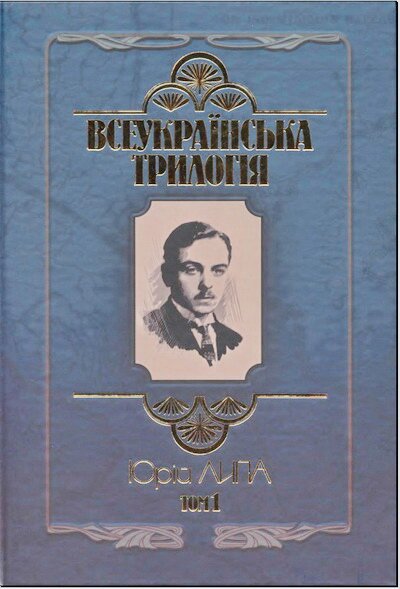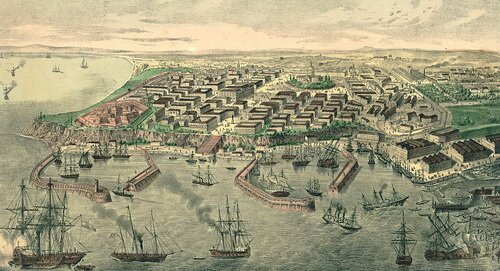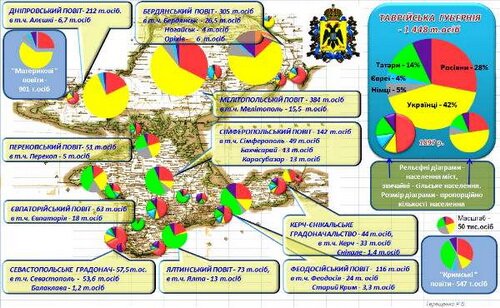
The Independent Analytical Center for Geopolitical Studies “Borysfen Intel” affords ground to the analysts generation for expressing their point of view regarding the political, economic, security, information situation in Ukraine and in the world in general, according to their personal geopolitical studies and analyses.
Note that an authors’ point of view
|
Valeriy Shvets, Professor
For thousands of years different peoples had been arriving in the Crimea and had been building, building, building. In ancient times the Crimea was known as a pearl of the ancient civilization.
I was already 56 years old when first visited the Crimea as a patient of one of health resorts. My state of health was not good. Morning exercises, a swimming pool, table tennis before dinner. Daily walks on the outskirts of Yalta in the afternoon. Daily walks eventually made 15 kilometers. Having explored the Big Yalta, I began to travel by local transport within a hundred kilometers or more around the resort. Such was my treatment. I returned from the Crimea physically stronger and in a positive mood. A new phase of my life began with a better understanding of its value and aim. Traveling over the Crimea, I noticed the poverty of its ancient cultural attractions, but in comparison with other lands of Ukraine, the Crimea may be proud of its past most of all. Ancient Greek cities, colonies which appeared here long before our era, the glorious kingdom of Bosporus, the powerful Crimean Khanate... Where is what was left of them? What has remained of Chersonese? All that remains of this largest of the famous Greek city — colonies (where Greek Church hierarchy baptized the Kiev Prince Volodymyr who subsequently baptized Rus), are the discovered in the last decades building foundations (although even they are strongly impressive). In the former capital of the Crimean Khanate — Bakhchisarai — the only reminder of the past is the Khan's palace. And not a single other building of those ancient times! According to one of my students who was born in that land, in the former capital of the Bosporus Kingdom — Kerch, there is nothing to remind of its glorious past. However, there is Mount Mithridatthere — named after the most famous king of the Bosporus Kingdom — which is dotted with small fragments of pottery and building stones.

Chersonesus. Ukraine appealed to UNESCO to protect cultural heritage in the Crimea
http://zn.ua/
Times of the classic Russian Empire best of all have been reflected in attractions of its architecture. Although there are no architectural masterpieces among them, but to some extent they neutralize the depressing effect of the squalid built-up environment of Soviet times.

Yuri Lypa “All Ukrainian trilogy” [Volumes 1-2] (2007)
http://toloka.hurtom.com/
The answer to the question, what happened to the ancient sights of the Crimea, I found in the Bible by modern Ukrainian Yuri Lypa “All Ukrainian trilogy. Volume1. Mission of Ukraine”,— “Here comes Moskal (a nickname for Russians) to Chersonese, filled with thousands-years-old Hellenistic and Roman buildings, statues and temples left untouched so far, both, by Tatars, and even by Huns”. And then the author gives eyewitness memories — the words of the Professor of Oxford University E. D. Clark:
“The ruins of Chersonese were still strong, and everywhere there were even doors. Once Moskal arrived, everything was destroyed at once. These barbarians took up their favorite pastime — ruining. They were turning over, breaking, burying and destroying everything they could get their hands on, and which testified about the ancient history of the country.
Here they come to Bakhchisarai, where there were not only the Arab-Tatars, but Gothic, Hellenic and Rusan (Kievan Rus) buildings. Russians satisfied their brutal pleasure with destruction, having destroyed this capital completely. The city had been divided into many parts: the Greek colony occupied the whole wide valley. New conquerors destroyed it completely, leaving no stone unturned.
In Kerch, the city of Mithridates the Great, Carthage of the Euxine Sea, filled with sights of three thousand years' history, Russians acted most cruelly. There, having seen a slender marble of glory and greatness, they showed themselves. In Kerch, having leveled five hundred buildings, among the ruins they allowed to build about thirty squalid barracks.
Had the Greek archipelago come under Russia's rule, there would not have remained current beautiful attractions of the ancient Hellados. Athena would have disappeared, and Moscovites' riders would not have left a root showing where the city used to be. Compared with Russians, even Turks seem educated and cultured“.
Further again, Yuri Lypa: “The Russians had to do it. Because centuries and millennia were looking at them with contempt from those temples, towers and buildings. Because beaten or federated peoples could have found in those things faith in themselves, in their own greatness, and above all in their uniqueness, in the beauty of their own organic life. And it would have been dangerous for the Russian Empire, for its rigidity.

Akkerman (Belgorod-Dniester fortress) - one of the largest and best preserved castles in Ukraine
http://www.kuluarbc.com.ua/
And what is left of Hadjibey, what is left of Ishmael? Everywhere — the same. Belgorod-Dniester fortress survived only because it came into the Russian empire too late. And where are the graves of our hetmans? And why ancient fortresses and temples survived only on the lands of the Western Ukraine which had been part of the Austrian Empire or of the Polish state? The Russian Empire was determined to count history of conquered lands from the moment when the first Russian soldier set foot on them. Such was this unique and extremely dangerous empire.

Odessa in 1850
http://ru.wikipedia.org/
The question of the age of Odessa in the scientific plane was settled long ago and does not cause academic discussions. It is approximately six hundred years. But why is Odessa still celebrating a little more than 200th birthday? That is not the historical date of birth, but the political one, left to us as legacy by the Modern Russian empire — the Soviet Union. The same in Sevastopol, whose age should be counted from the age of Chersonesos. The same throughout the whole Eastern Ukraine.
What has happened to the population of the Crimea? For millennia the Crimea kept absorbing different ethnic groups, like a sponge absorbs water, not letting anyone outside its borders. Tauris, Greeks, Scythians, Sarmatians, Rusans, Tatars — this is not a complete list of the most important peoples, who came to stay here forever, becoming the Crimean-Tatar people. For centuries people had been moving to the Crimea. Too attractive and fertile was the Crimean land. And now for the first time in the history of the Crimea the direction of migration had changed dramatically. The reason for these changes was two Russian-Turkish wars of 1768-1774 and 1787-1791. During the first of these wars, Russians completely conquered the Crimea. From the beginning to the end of the war an active part in it on the side of Russia took the Cossacks of Ukraine. Consequence of the Russian-Turkish war of 1768-1774 was signing of Kuchuk-Kainarji Agreement in 1774, under which the Crimea was declared independent from the Ottoman Empire. This war ended in the defeat not only of the Turkish-Tatar coalition, but also of the Ukrainian side. After the Cossacks had returned from the war, Zaporizhzhyan Sich was surrounded by Russian troops (led by General P. Tekeliy, also returning from the Turkish front) and destroyed. Looks like Russians had a definite plan about the Crimea, and the free Ukrainian Cossacks prevented its implementation. Confirmation of this assumption is the fact that during the war, in 1780 to be exact, in the Crimea was released 120.000 Ukrainian slaves, soon forcefully deported from the Crimea to the mainland of Ukraine.

Kuchuk-Kainarji Agreement - a treaty concluded 10 (21) July, 1774 between the Russian and Ottoman (Turkish) Empires. The document ended the Russo-Turkish War of 1768–1774
http://history.mk.ua/
In 1783 Russia, breaking the just signed agreement with Turkey, annexed the Crimea. It is difficult to accurately determine the number of the Crimean population of those times. Various authors give different numbers. In the book by Nicholas Galichanets “Our Ukrainian Crimea”, the following data are presented. At that time in the Crimean Khanate there lived 1 million 235 thousand Ukrainians, 650 thousand Tatars and 36 thousand people of other nationalities. Including in the Peninsula itself there lived 900 thousand Ukrainians and 110 thousand Tatars. Note that this number of the Crimean population was then reached only in the late twentieth century. Deportation of Ukrainians began in 1784. They were first people deported from the Crimea. Russian military units combed the territory, forcing the residents of Ukrainian villages to leave the Peninsula. Large swaths of Ukrainians, one village after another, — on horseback, on oxen, on cows, or simply pulling carts with personal belongings, set off, escorted by Russian soldiers, for Perekop.
Interestingly, along with Ukrainians, the rest of the Crimean population began being deported: Greeks, Armenians, Arabs, Karaites and so on. These were mainly artisans, traders and merchants.
For over three hundred years Tatars had been driving captured Ukrainians to the Peninsula. Despite all their misfortunes, the Crimea became a new homeland for most of them. Now Russians were forcefully driving Ukrainians out from there. During 1784-1785 almost the entire rural Ukrainian population of the Crimea was deported. The steppe, foothills, mountain valleys turned into desert, untreated fields were overgrown with weeds, orchards and vineyards were orphaned. In 1786-1788 the rest of Ukrainians were deported from towns, villages and ports.
In 1785, after the deportation of Ukrainian villagers began the deportation of the Crimean Tatars. They were driven out not only from the Crimea, but also from Ukraine. The deserted huts were simply burned off. In 1786, Russians started the deportation of Tatars from outside the Peninsula. Those were Bugeac, Edisan, Dzhamboy, Edichkul uluses. Tatars were deported actually within one year.
Instead of the deported Crimean indigenous people they started bringing in ethnic Russians. In the late eighteenth century, the latest population of the Crimea, soldiers and officials included, made more than 100 thousand people.
In the early nineteenth century in the Crimea was clearly seen an economic decline. Standards of living of the population were below the poverty line. Ruins of towns and villages were all over, the lands were completely desolated.
Note that in the same proportions the migration processes were observed in the North Caucasus after the Russian victory in the Caucasian War. The Russian Empire had always sought to seize the land, but did not know how to handle it and did not desire to. It did not need the local population. By the way, it was the same in the days of the modern Russian Empire — the Soviet Union. Millions of Ukrainians were destroyed in their homeland or were deported to remote regions of the Soviet Union, and in their place were resettled powerful streams of imperial people. The Russian Empire's conquering new territories had always meant for the local a destruction — both, civilization and ethnic one.

Population of the Taurida Governorate on the 1897 census
http://lenta-ua.net/
Even in the late nineteenth century the population of the Crimea did not return to the number of the times of the Crimean Khanate. Based on the first all-Russian census, in 1897, in the Peninsula lived only 268 thousand people. Of these, 130 thousand were official migrants — mainly ethnic Russians. The rest were remnants of the indigenous population of the Crimea, who crook returned to their land. Primarily they were Ukrainians. Percentage of the population was as follows: 85 % were Russians (to whom were added on all Ukrainians), 6 % — Germans, 4 % — Jews, 3 % — Greeks, 1.5 % — Armenians, and 0.5 % — Tatars.
Finally, in 1918 there a Ukrainian state appears. Most effective it looked at the times of Hetman Skoropadskyi, supported with all the might by the German Empire. The Crimea at the time was a part of Ukraine.
True, it was so for a very short time, less than a year. Such was the fate of Ukrainian Hetman Skoropadskyi, which was closely intertwined with the fate of Germany. After the period Hetmanat, no one thought about the Crimea and Kuban, as part of the Ukrainian territory. But the leadership of the modern Russian empire remembered about this and did everything possible to once again turn the Crimea into the desert and to start populating it again with imperial people.
